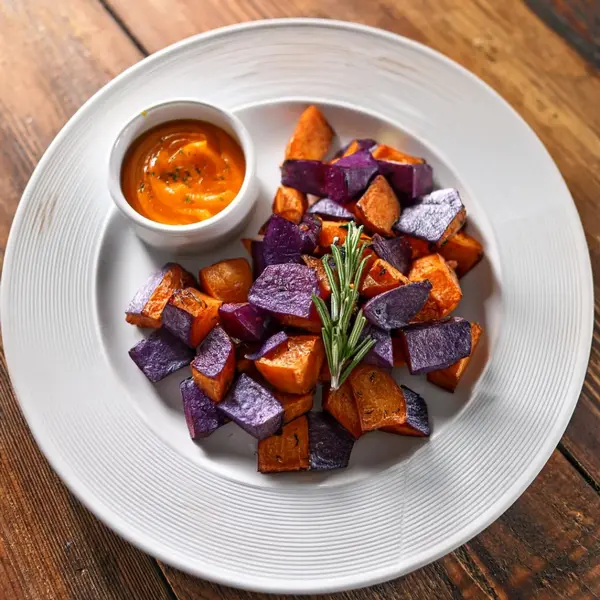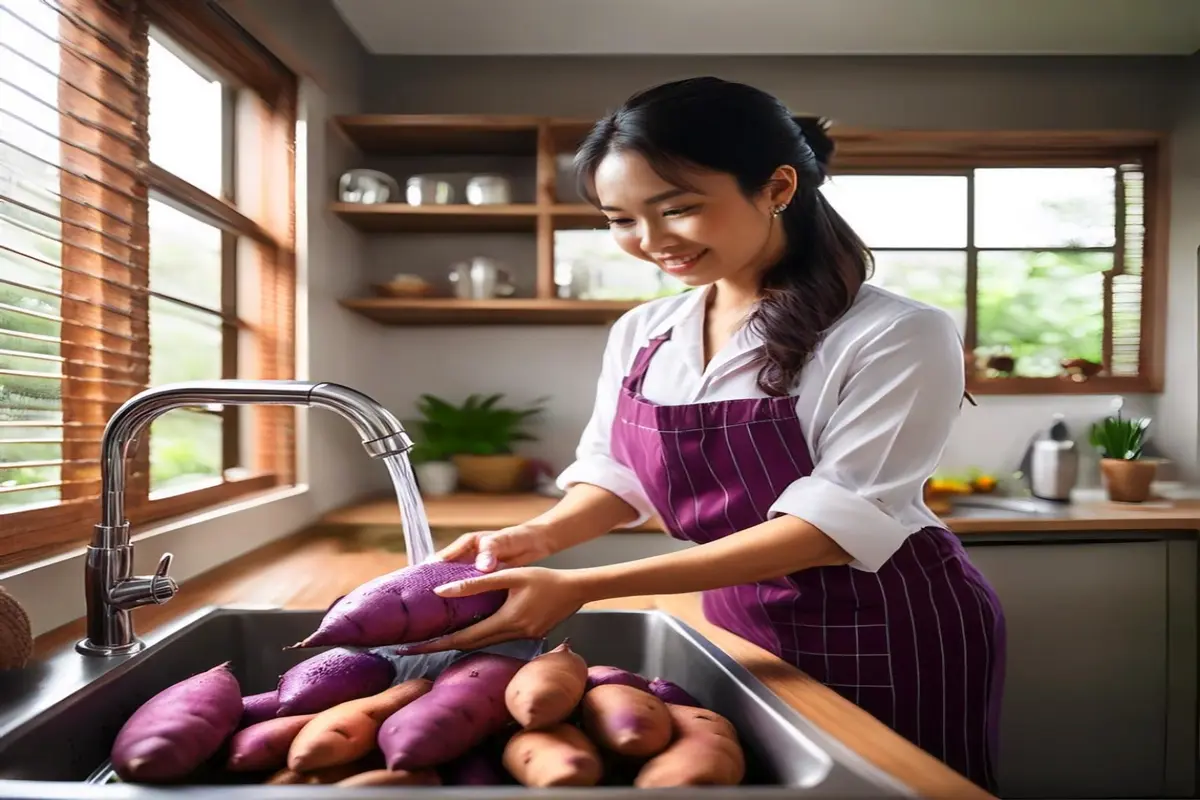Introduction :
Purple sweet potatoes are not just visually stunning; they pack a nutritional punch too. Yet, one common question among home cooks is: should you peel purple sweet potatoes? The answer isn’t as straightforward as you might think! From understanding their unique skin benefits to learning how peeling affects their flavor and texture, this guide will walk you through every aspect of purple sweet potatoes — from peeling decisions to cooking tips and even a delicious recipe to try at home.
Let’s dive in and answer this age-old kitchen question while exploring the nutritional perks and preparation methods for these vibrant root vegetables.
What Are Purple Sweet Potatoes?
Purple sweet potatoes are a type of root vegetable that comes in several varieties, such as Okinawan and Stokes. Their signature deep purple color isn’t just beautiful to look at — it’s also a sign of their rich antioxidant content, especially anthocyanins, which give them their distinct hue. But what makes purple sweet potatoes different from their orange cousins?
Unlike regular sweet potatoes, purple ones tend to have a drier texture and a mildly nutty flavor. They’re also packed with fiber, vitamins, and minerals, making them a healthy addition to any meal. However, when it comes to preparing them, you might wonder if peeling the skin is necessary.
Now, let’s take a closer look at why the skin matters.
Nutritional Benefits of Purple Sweet Potatoes
Did you know that the skin of purple sweet potatoes contains a significant portion of their fiber content? Leaving the skin on can boost your intake of dietary fiber, which helps support digestion and promote heart health. Additionally, the skin is rich in antioxidants, which may protect your cells from damage caused by free radicals.
In fact, most of the nutrients in sweet potatoes are found close to the skin. Removing it means losing out on some essential vitamins and minerals like potassium, iron, and vitamin C. So, if you’re peeling purple sweet potatoes, you’re potentially throwing away some of their nutritional goodness.
Texture and Flavor Considerations
Although keeping the skin provides nutritional benefits, not everyone enjoys the texture. Purple sweet potato skin can be a bit tough and chewy, especially if the potatoes are baked or roasted. However, the good news is that the skin softens significantly when boiled or steamed.
If you’re aiming for a smoother texture in your dish, peeling might be the better option. But if you want a rustic look and more fiber, keeping the skin on is a great choice. Ultimately, it comes down to personal preference and the cooking method you choose.
Still on the fence? Let’s weigh the pros and cons of peeling versus not peeling your purple sweet potatoes.
Health Benefits of Anthocyanins
Interestingly, the vibrant purple color of these sweet potatoes isn’t just for show. The pigments that give purple sweet potatoes their color are called anthocyanins, which are powerful antioxidants. According to Wikipedia, these antioxidants are known for their potential to reduce inflammation and support cardiovascular health.
Why Cooking Method Matters
Before you make your decision, think about how you plan to cook your purple sweet potatoes. For instance, baking and roasting tend to make the skin tougher, while boiling or steaming keeps it tender. In the next section, we’ll explore how various cooking methods affect your decision to peel or not to peel.
Should You Peel Purple Sweet Potatoes? Pros and Cons
When it comes to deciding whether you should peel purple sweet potatoes or not, it’s essential to weigh the pros and cons. This decision can impact both the nutritional value of your dish and its overall taste and texture. While some people prefer the rustic look and earthy flavor that the skin provides, others prefer a smoother texture. Let’s dig into the benefits and drawbacks of peeling these beautiful root vegetables.
Pros of Leaving the Skin On
One of the most compelling reasons to leave the skin on purple sweet potatoes is the nutritional boost it provides. The skin is packed with fiber, which is vital for healthy digestion. Plus, leaving the skin intact means you’ll retain more vitamins and minerals that are found just beneath the surface. Peeling sweet potatoes can strip away these nutrients, which are essential for maintaining good health.
In addition to their health benefits, the skin adds a unique texture to dishes. When roasted or baked, the skin becomes slightly crispy, creating a delightful contrast to the creamy flesh inside. Moreover, keeping the skin on saves time in the kitchen — no peeling required!
But that’s not all! The skin is also loaded with antioxidants, such as anthocyanins, which have been linked to numerous health benefits, including reducing inflammation and improving brain function.
Cons of Leaving the Skin On
While there are many benefits to leaving the skin on, there are a few downsides to consider. For starters, the skin can be a bit tough and chewy, especially if the sweet potatoes are not cooked properly. Some people might find this texture unappealing, particularly in dishes that are meant to be smooth and creamy, like mashed sweet potatoes.
Another consideration is the potential for dirt and debris to remain on the skin, even after washing. To minimize this risk, make sure to scrub the potatoes thoroughly under running water before cooking. It’s also worth noting that if you’re buying non-organic purple sweet potatoes, the skin may contain pesticide residues, which could be a concern for some.
When Should You Peel Purple Sweet Potatoes?
The decision to peel or not depends largely on how you plan to cook the sweet potatoes and the dish you’re preparing. For example:
- Leave the skin on if you’re roasting, baking, or grilling the sweet potatoes. The skin will crisp up nicely and add texture to the dish.
- Peel the skin if you’re making mashed sweet potatoes, soups, or desserts where a smoother texture is desired.
Interestingly, some traditional dishes made with purple sweet potatoes, such as Okinawan dishes, often keep the skin on to maximize the flavor and nutritional benefits.
A Quick Tip for Easier Peeling
If you prefer to peel purple sweet potatoes but find it tedious, try boiling them first. Once they’re cooked, the skin can be easily removed by gently rubbing it with your fingers. This method not only saves time but also helps retain more nutrients compared to peeling them raw.
Now that we’ve covered the pros and cons, it’s time to explore how different cooking methods can influence your peeling decision. Let’s move on to the next section, where we’ll discuss how boiling, baking, and roasting impact the texture and flavor of purple sweet potatoes.
How Cooking Methods Affect Peeling Decisions
The way you cook your purple sweet potatoes can make a big difference in whether you should peel them or leave the skin on. Each cooking method has its pros and cons, and understanding how these methods affect texture, flavor, and nutrients will help you make an informed decision. Let’s explore how boiling, baking, roasting, and steaming impact whether peeling is necessary.
Boiling Purple Sweet Potatoes: To Peel or Not to Peel?
Boiling is one of the most common ways to prepare purple sweet potatoes, and it’s also the easiest method for those who prefer peeled potatoes. When you boil them, the skin softens significantly, making it easier to peel off afterward. In fact, if you boil them whole, the skin often slips right off with just a gentle tug.
However, boiling also has a downside: it can cause some of the water-soluble nutrients, like vitamin C and certain antioxidants, to leach into the cooking water. If you’re looking to preserve as many nutrients as possible, you might want to consider leaving the skin on during boiling. Not only does the skin act as a protective barrier, but it also helps retain the potato’s vibrant purple color.
💡 Pro Tip: If you choose to peel the potatoes after boiling, wait until they’ve cooled slightly to avoid burning your hands. The skin will come off much more easily when the potatoes are warm but not hot.
Baking and Roasting: Why the Skin Matters
Baking and roasting are among the best cooking methods if you want to maximize flavor. When purple sweet potatoes are roasted, their natural sugars caramelize, creating a rich, sweet flavor that pairs beautifully with savory herbs like rosemary and thyme.
In this case, leaving the skin on is often the preferred choice. The skin becomes slightly crispy during roasting, adding a delightful contrast to the soft, creamy interior. Plus, roasted purple sweet potatoes with the skin on look more rustic and visually appealing.
If you’re not a fan of the texture, you can always peel them before baking. But keep in mind that you’ll lose some of the nutrients and antioxidants that are concentrated in the skin.
Steaming: A Nutrient-Preserving Method
Steaming is one of the healthiest ways to cook purple sweet potatoes because it helps retain more nutrients compared to boiling. This method also keeps the potatoes moist and tender without making the skin tough.
If you prefer to eat the skin, steaming is a great option since it softens the skin without making it chewy. However, if you’re planning to mash or puree the sweet potatoes, you might want to peel them after steaming for a smoother texture.
Frying and Sautéing: Should You Peel First?
For dishes that involve frying or sautéing purple sweet potatoes, peeling them is generally recommended. The skin can become chewy or leathery when exposed to high heat for extended periods, which might not be the texture you want in a crispy dish.
That said, if you’re making sweet potato fries, leaving the skin on can give them a rustic appearance and boost their fiber content. Just be sure to scrub the potatoes well to remove any dirt or debris.
Which Cooking Method Is Best for You?
Ultimately, the best cooking method depends on the dish you’re preparing and your personal preference. If you’re aiming for a hearty, rustic dish, leaving the skin on during roasting or baking is a great choice. On the other hand, if you’re going for a smoother texture, like in mashed sweet potatoes or purees, peeling them first might be better.
By now, you should have a good idea of how cooking methods affect your decision to peel or not to peel. In the next section, we’ll dive into a delicious recipe that showcases purple sweet potatoes at their best.
Recipe – Roasted Purple Sweet Potatoes with Garlic and Herbs

Now that we’ve explored whether you should peel purple sweet potatoes and how various cooking methods impact that choice, it’s time to put theory into practice. Here’s a foolproof recipe for Roasted Purple Sweet Potatoes with Garlic and Herbs that brings out the best flavors and textures of these beautiful root vegetables. Whether you choose to peel them or leave the skin on, this dish will quickly become a favorite in your kitchen.
Ingredients
- 4 medium purple sweet potatoes (peeled or unpeeled, your choice)
- 2 tablespoons olive oil
- 4 cloves garlic, minced
- 1 teaspoon fresh rosemary, chopped
- 1 teaspoon fresh thyme, chopped
- ½ teaspoon salt (or to taste)
- ¼ teaspoon black pepper
- Optional: 1 tablespoon balsamic vinegar for added flavor
Step-by-Step Cooking Instructions
Step 1: Preheat the Oven
Start by preheating your oven to 400°F (200°C). A hot oven is key to achieving that perfect caramelization on the sweet potatoes.
Step 2: Wash the Purple Sweet Potatoes
If you decide to leave the skin on, scrub the sweet potatoes thoroughly under running water to remove any dirt. Pat them dry with a clean towel. If you prefer to peel them, use a vegetable peeler to remove the skin before washing.
Step 3: Cut the Sweet Potatoes
Slice the sweet potatoes into 1-inch cubes. Keeping the pieces uniform in size ensures even cooking.
Step 4: Season the Sweet Potatoes
In a large bowl, combine the olive oil, minced garlic, rosemary, thyme, salt, and pepper. Toss the sweet potato cubes in the mixture until they’re evenly coated. If you’re a fan of bold flavors, you can also add a pinch of paprika or cayenne pepper.
Step 5: Arrange on a Baking Sheet
Line a baking sheet with parchment paper or lightly grease it with olive oil. Spread the sweet potatoes in a single layer on the sheet, ensuring they aren’t overcrowded. This allows them to roast evenly and prevents steaming.
Step 6: Roast the Sweet Potatoes
Place the baking sheet in the preheated oven and roast for 25-30 minutes, flipping the sweet potatoes halfway through cooking. They should be tender on the inside and crispy on the outside.
Step 7: Add Finishing Touches
Once the sweet potatoes are golden brown and caramelized, remove them from the oven. If desired, drizzle them with balsamic vinegar for a tangy twist. Garnish with extra rosemary or thyme for a fresh, aromatic touch.
Step 8: Serve and Enjoy
Transfer the roasted sweet potatoes to a serving dish and enjoy them hot. They make an excellent side dish for roasted meats, salads, or grain bowls.
Nutritional Content (Per 100g)
| Nutrient | Amount |
|---|---|
| Calories | 110 kcal |
| Carbohydrates | 24 g |
| Protein | 2 g |
| Fat | 1.5 g |
| Fiber | 3 g |
| Sugars | 5 g |
| Vitamin A | 8500 IU |
| Vitamin C | 2.5 mg |
| Calcium | 30 mg |
| Iron | 0.7 mg |
This recipe demonstrates how versatile purple sweet potatoes can be, whether you choose to peel them or not. The garlic and herbs complement the natural sweetness of the potatoes perfectly, making this dish a must-try.
In the next part, we’ll address frequently asked questions to help you make the best use of your purple sweet potatoes.
Frequently Asked Questions (FAQs) About Purple Sweet Potatoes
After learning how to cook purple sweet potatoes and deciding whether or not to peel them, you may still have a few lingering questions. In this section, we’ll answer some of the most common questions people have about purple sweet potatoes — from their health benefits to how to store and prepare them for the best results.
Can You Eat Purple Sweet Potato Skin?
Yes, absolutely! The skin of purple sweet potatoes is edible and contains valuable nutrients like fiber, antioxidants, and vitamins. In fact, many people prefer to leave the skin on because it enhances the nutritional profile of the dish. The skin also contains anthocyanins, the compounds responsible for the vibrant purple color, which have been linked to anti-inflammatory and heart-healthy benefits.
That said, not everyone enjoys the texture of the skin, especially when baked or roasted. If you’re looking for a smoother dish, like mashed sweet potatoes or a creamy soup, peeling the skin might be a better option. But remember, leaving the skin on is the easiest way to retain more nutrients.
How Do You Properly Clean Purple Sweet Potatoes?
If you plan to leave the skin on, it’s important to clean your purple sweet potatoes thoroughly. Here’s how to do it:
- Rinse Under Running Water: Hold the sweet potatoes under cold running water to remove any dirt and debris.
- Scrub with a Brush: Use a vegetable brush to scrub the skin gently, focusing on any crevices where dirt may be trapped.
- Dry Thoroughly: Pat the sweet potatoes dry with a clean kitchen towel before cooking.
For those who prefer to peel their potatoes, it’s still a good idea to wash them first. This ensures that any dirt or pesticides are removed before peeling.
Do Purple Sweet Potatoes Taste Different from Orange Sweet Potatoes?
Yes, they do. Purple sweet potatoes tend to have a slightly nuttier and less sweet flavor compared to their orange counterparts. Their texture is also denser and drier, making them ideal for roasting and baking. In contrast, orange sweet potatoes are softer and sweeter, which makes them more suitable for mashed dishes or desserts.
Interestingly, the flavor of purple sweet potatoes becomes richer when roasted or baked. They develop a natural sweetness that pairs well with savory herbs like rosemary, thyme, and garlic.
What Are the Health Benefits of Purple Sweet Potatoes?
Purple sweet potatoes are nutritional powerhouses. Here are some of the key health benefits:
- Rich in Antioxidants: The anthocyanins in purple sweet potatoes help reduce inflammation and protect against chronic diseases.
- High in Fiber: Eating the skin provides additional fiber, which supports digestive health and helps maintain stable blood sugar levels.
- Boosts Immune System: Purple sweet potatoes contain vitamins A and C, which are essential for a strong immune system.
- Supports Heart Health: The potassium in purple sweet potatoes helps regulate blood pressure and maintain heart health.
Incorporating purple sweet potatoes into your diet is a delicious way to boost your nutrient intake.
How Can You Tell When Purple Sweet Potatoes Are Cooked?
Knowing when your sweet potatoes are perfectly cooked can be tricky. Here’s a quick guide based on cooking methods:
- Boiled: They’re done when you can easily pierce them with a fork. This usually takes about 20-30 minutes, depending on their size.
- Baked or Roasted: Purple sweet potatoes are ready when they’re tender on the inside and caramelized on the outside. This typically takes 25-30 minutes at 400°F (200°C).
- Steamed: They should be soft and tender after about 20-25 minutes.
Overcooking can make them mushy, so keep an eye on them as they cook!
Can You Freeze Purple Sweet Potatoes?
Yes, you can freeze both cooked and raw purple sweet potatoes. Here’s how:
- For Raw Sweet Potatoes: Peel and chop them into cubes, then blanch in boiling water for 2-3 minutes. Drain, cool, and store in airtight freezer bags.
- For Cooked Sweet Potatoes: Let them cool completely before placing them in a freezer-safe container. They can be frozen for up to 6 months.
Freezing is a great way to preserve sweet potatoes if you’ve bought more than you can use right away.
Final Recommendations and Conclusion

After exploring the pros and cons of peeling purple sweet potatoes, examining different cooking methods, and trying out a delicious recipe, it’s clear that the decision to peel or not to peel depends largely on your preferences and the dish you’re preparing. However, there are a few key takeaways to keep in mind when working with these nutrient-packed root vegetables. Let’s wrap things up with some final recommendations and helpful tips for getting the most out of your purple sweet potatoes.
Key Takeaways: To Peel or Not to Peel?
If you’ve been wondering whether you should peel purple sweet potatoes, the answer isn’t black and white. Here are some general guidelines to help you decide:
- Leave the skin on if you’re baking, roasting, or grilling the sweet potatoes. The skin will become crispy, adding texture and retaining more nutrients.
- Peel the skin off if you’re making mashed sweet potatoes, creamy soups, or desserts where a smoother consistency is preferred.
- Always wash thoroughly if you decide to keep the skin. Scrubbing under running water will remove any dirt, debris, or pesticide residue.
Ultimately, there’s no right or wrong answer. The best choice depends on how you plan to use the sweet potatoes and your personal taste preferences.
Final Cooking Tips for Purple Sweet Potatoes
Cooking purple sweet potatoes can be simple and rewarding if you follow a few tips:
- Choose the Right Potatoes: Look for firm, unblemished purple sweet potatoes with smooth skin. Avoid any that have soft spots or cracks.
- Store Properly: Keep them in a cool, dry place away from direct sunlight. Purple sweet potatoes can last for several weeks if stored correctly.
- Try Different Cooking Methods: Experiment with boiling, baking, roasting, and steaming to find your preferred way of preparing them.
- Pair with Bold Flavors: Purple sweet potatoes pair well with garlic, rosemary, thyme, and even a touch of citrus. Don’t be afraid to get creative in the kitchen!
- Preserve the Color: To retain their vibrant purple color, avoid overcooking. Steaming is a great method to preserve both color and nutrients.
Nutritional Benefits at a Glance
Purple sweet potatoes aren’t just a pretty addition to your plate — they’re packed with health benefits. Here’s a quick summary:
| Nutrient | Benefit |
|---|---|
| Anthocyanins | Powerful antioxidants that reduce inflammation and support heart health. |
| Fiber | Supports digestive health and helps maintain stable blood sugar levels. |
| Vitamin A | Essential for healthy vision and immune function. |
| Potassium | Helps regulate blood pressure and supports heart health. |
| Vitamin C | Boosts the immune system and supports collagen production. |
Including purple sweet potatoes in your meals is a delicious way to improve your diet and support overall health.
Conclusion: What’s the Final Verdict?
So, should you peel purple sweet potatoes? The choice is yours! If you’re looking to maximize the nutritional benefits and enjoy a more rustic texture, leaving the skin on is the way to go. However, if you’re aiming for a smoother texture or prefer a more refined dish, peeling the sweet potatoes might be a better option.
No matter what you choose, purple sweet potatoes are a versatile and nutritious ingredient that can be used in a variety of dishes. Whether you’re roasting them for a hearty side dish or mashing them into a creamy puree, these vibrant potatoes are sure to bring both color and flavor to your table.
Final Thoughts: A Healthy and Delicious Choice
At the end of the day, purple sweet potatoes offer a unique combination of stunning color, delicious flavor, and impressive health benefits. Whether you’re a seasoned home cook or just experimenting in the kitchen, adding purple sweet potatoes to your repertoire is a smart and tasty move.
Remember, there’s no one-size-fits-all approach to preparing purple sweet potatoes. The best way to enjoy them is to experiment with different methods, try new recipes, and find what works best for your taste buds.

